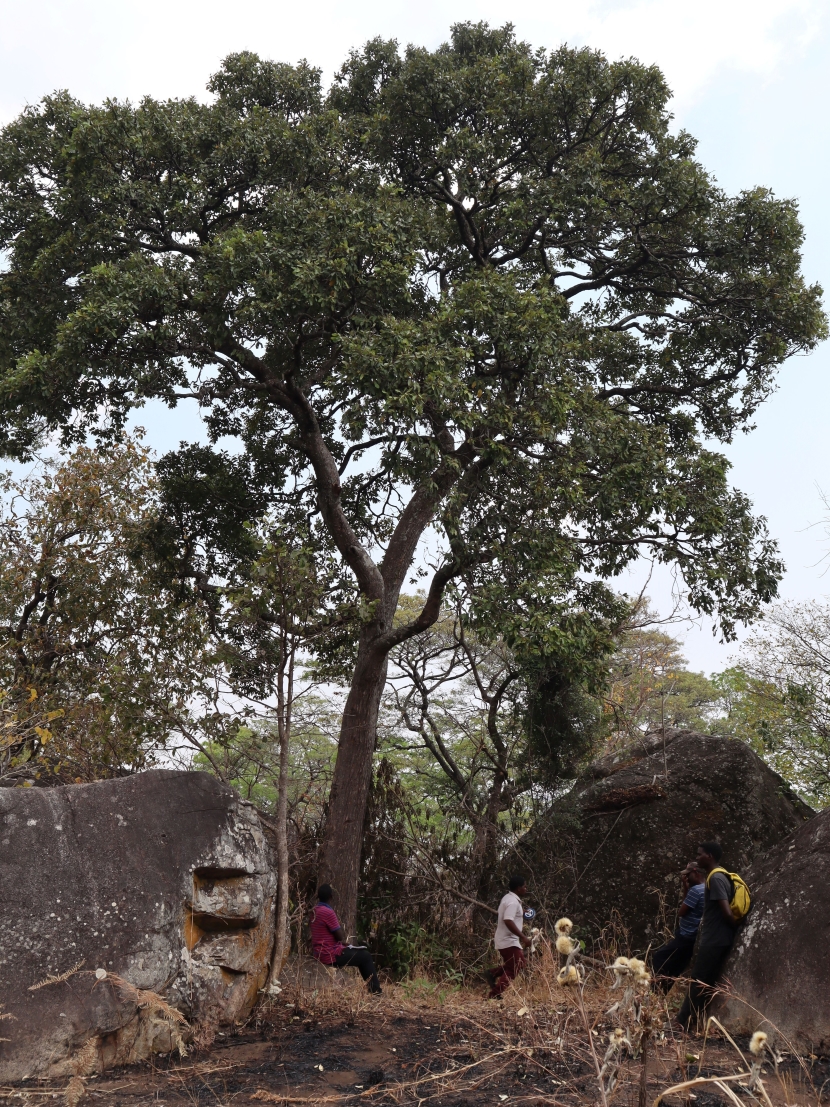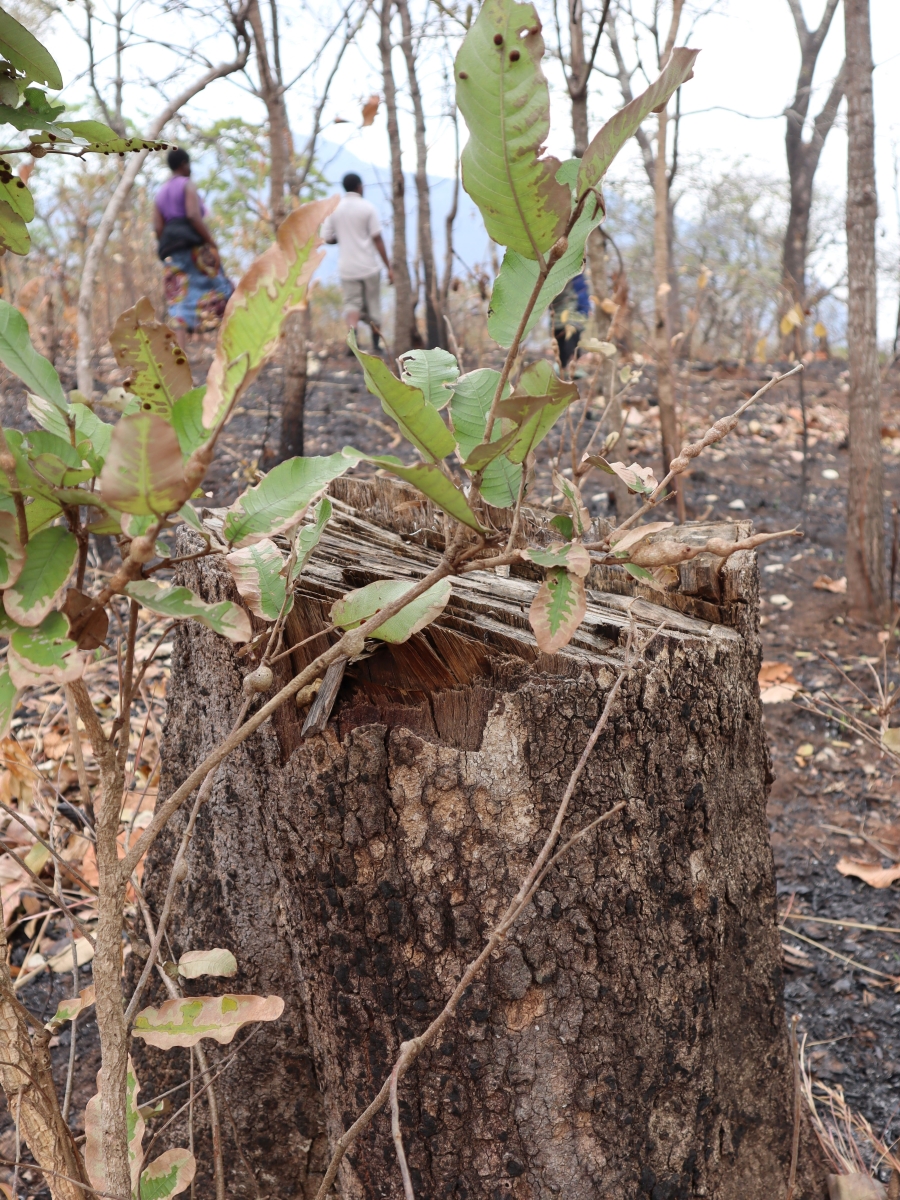Magical miombo larder on Mount Mulanje

The crown of a Parinari curatellifolia tree in Tchete co-management block. Credit - Kate Chanthuny.
Magical miombo larder on Mount Mulanje
African miombo woodland is a widespread dry habitat that is biodiverse and extremely valuable to people. Firstly, they are home to many plant species that provide people with food, medicines, and materials to build homes and keep them healthy, as they have done for generations. They also provide people with fuelwood to cook with, of vital importance to those in rural and urban areas.
It is the use for fuelwood coupled with growing urban communities, poverty, and few income opportunities in rural areas that are one of the biggest threats to miombo. Wood is burned directly or converted to charcoal to sell to towns and cities to cook with. With a lack of alternatives, this is vital to people’s survival. The Mulanje Mountain Biosphere Reserve (MMBR) in southern Malawi is no different. Struggles for Malawians in Mulanje are further exacerbated by two-fold effect of cyclones, like Cyclone Freddy earlier this year: the loss of their household maize crop from flooding, and the subsequent increase in price of maize per bag.
"Community members could play a leading role on whether sustainable use of indigenous trees, like Maula, is possible in Mulanje."
It is around this biosphere reserve that Botanic Gardens Conservation International (BGCI), Mulanje Mountain Conservation Trust (MMCT), TRAFFIC – FairWild, and WeForest are working to create alternative opportunities with local communities, using Darwin Initiative support in a project titled ‘Improving Community Sustainable Natural Resource Management of Mount Mulanje.’
Mandanda and the Maula
Mandanda is a group of villages below Mount Mulanje, separated from the forest reserve by the Likhubula river. Villagers are mostly subsistence farmers, and they rely on the sale of firewood and charcoal harvested from the MMBR to supplement their incomes. We are developing new livelihood revenue streams so that villages like these have alternative and more sustainable options.
Community engagement and sensitisation activities - meetings with Village Heads and Group Village Heads (local leaders) - were the first steps. These introduced an understanding of the potential economic benefits that the indigenous fruit trees found naturally in the Miombo could bring. Most wild fruits were considered supplementary to people’s diets. Parinari curatellifolia – locally called Maula – for example, is only eaten ‘out of hand’ when in the reserve collecting firewood, or by children.
However, native plants can be high in important micro- and macronutrients and so should be valued and eaten much more widely. Maula fruit, for example, is packed with potassium, magnesium, manganese, copper, zinc, iron, phosphorous, and vitamin C, whilst the seed kernels are high in protein and unsaturated fat. It has also been recorded as an important dry season food due to its high carbohydrate content.

Chris Banda, a harvester of Parinari curatellifolia fruits in the recent trials, holding fruits from the tree. Credit - Kate Chanthunya.
Maintaining native plants in the landscape is important to biodiversity too. Maula trees can stand over 20m high and with 30m diameter crowns, often left remnant in Mulanje’s populated areas – surrounded by tea plantations and maize fields. There, they act as functional island refuges for much of Mulanje’s native fauna; flowering profusely in the dry season, they are an important nectar source for wild bee and butterfly species. Butterflies also lay their eggs on the leaves as a host plant for their caterpillars, while fruit bats, fructivorous birds, and squirrels eat the fruits, dispersing their seed.
Trialling new markets
In September this year, a controlled trial purchase of Maula fruit took place, at the house of the Mandanda Group Village Head. 345kg of ripe fruit were bought from 23 community members. They were paid between 700 and 1,000 Malawian Kwacha (MWK – about 50-75p) per kilogram, in an area (Mulanje and Phalombe districts) where annual consumption expenditure per person can be between just 173,324 MWK and 188,657 MWK (£130-£140). These fruits were harvested from trees on the edge of the villages near the Likhubula river, around fields of subsistence agriculture.
"By building new markets for native plants and fungi, the project aims to provide more sustainable Malawian food systems by using scientific expertise and business structures that help to make these markets fair to people and nature."
Collectors like Chrissy Banda (see image) took the research team to the main trees she collects from for GPS mapping, taking the opportunity to collect a few more fruit. Chrissy is happy to have found a new source of income for her family. Other collectors made comments about how these mature trees have new value for them, and how they will now protect them. On receiving money, most of the women said that they would use it to buy essential foods for their family. During the sales, several children were also seen eating the ripe fruit that their mothers were selling, maybe triggering an increase in local consumption of fruits and seeds which in turn helps to diversify local diets.
Moving forward, food products will be made, and sold, from the collected fruits. Many community members expressed interest in learning value-addition activities at the household level, leading to plans for sun-drying and more effective methods of seed drying, and kernel extraction to be taught to them.
These individuals could play a leading role on whether sustainable use of indigenous trees, like Maula, is possible in Mulanje. Although seasonal, the collection and sale of wild indigenous fruit has a high return for labour invested, and is therefore considered a favourable activity by community members.

Supporting new business developments
The Malawi Ministry of Industry and Trade has been supporting the sensitisation of communities to co-operatives and how they can be used in new businesses to benefit their members. A new group will be supported to harvest native plants and fungi to earn incomes. A social enterprise has been established that will then act as a packaging and marketing centre for new products to reach higher end markets.
Meanwhile, FairWild have been supporting the team to understand the FairWild standard and how to use it to assess wild harvesting impacts on the natural plant populations and community development. This will link to a new standard for fungi, and to expertise from South Africa in value chain development, organic farming, and FairWild value chain impact assessment. The FairWild team will also provide contact with potential international markets in the future via their network.
"The project’s success would signal potential for replication in many parts of southern Africa, providing impact even further afield."
Promoting fuelwood alternatives
As well as new income streams, the project also seeks to change behaviours and attitudes towards fuelwood use. The project partners worked together to design an engagement and outreach programme locally using Behaviour Centre Design (BCD) framework by Rare.
BCD provides steps to engage stakeholders – from government, NGO institutes, and local communities – to understand why damaging practices are done – in this case unsustainable charcoal production – positive and negative opinions, and what people would like to see in the future. This fed into the education and awareness campaign designs, to align messages with local people’s behaviours, thoughts, and beliefs so that they may be more impactful.
We learnt that some people incorrectly believe Malawi’s Forestry Act means that any trees planted on their land, outside the reserve, are owned by the government and so require permits to harvest. It was decided that a radio campaign would be developed to dispel this myth so that people understand they can plant trees and shrubs on their land to provide them with local firewood stocks for the future.

It was also discovered that people see some men from outside of the area seeking to marry women from local villages temporarily, to gain access to local resources for charcoal production. With a matrilineal culture it is normal for a husband to move into his wife’s household, since women are the owners of land. However, these men move on, leaving their new family when the local resources are depleted. The second component of the awareness campaign will therefore carry out leadership training, followed by community meetings to raise awareness about this practice, as well as the overall negative impacts of unsustainable charcoal. By building new markets for native plants and fungi, and in raising awareness of damaging practices, the project aims to provide more sustainable Malawian food systems around MMBR by using scientific expertise and business structures that help to make these markets fair to people and nature. With the miombo found from Angola to Tanzania, from East to West, and down South to Botswana, Zimbabwe, and Mozambique, the project’s success would signal potential for replication in many parts of southern Africa, providing impact even further afield.
Written by Kate Chanthunya and Alex Hudson. For more information on this Darwin Initiative Main project 29-014, led by Botanic Gardens Conservation International (BGCI), please click here.

 Back
Back